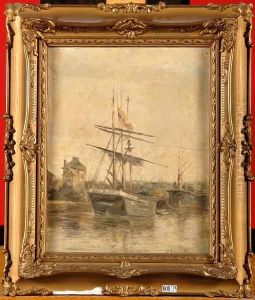A Boudin Paintings
Eugène Boudin was a French landscape and marine painter, born on July 12, 1824, in Honfleur, Normandy, France. His art is pivotal in the transition from the traditional approach of the landscape to the more spontaneous outdoor practice of Impressionism. Coming from a modest background, his family moved to Le Havre in 1835, where his father worked as a harbor pilot. It was in Le Havre where Boudin was exposed to the world of art, initially working in a frame shop where he met various artists, including Jean-François Millet, who encouraged him to consider a career in painting.
Boudin is especially renowned for his seascapes and for being one of the first French artists to paint outdoors, a practice that would later become a hallmark of the Impressionist movement. Despite his association with Impressionism, Boudin never fully embraced the movement's radical techniques and color palette but instead provided a critical link between the plein air practices of the Barbizon school and the more light-focused work of the Impressionists. His dedication to capturing the changing skies, the sea, and the bustling beach scenes of Normandy and Brittany earned him the nickname 'King of the Skies' among his peers.
In 1858, Boudin met the young Claude Monet, who was about 18 at the time. Boudin mentored Monet and encouraged him to paint outdoors, significantly influencing Monet’s development as a leading Impressionist painter. Despite his influence on the younger generation of artists, Boudin's work did not receive significant recognition until later in his career. It was only in 1889, at the age of 65, that he was awarded the Legion of Honor, France's highest order of merit for military and civil merits.
Boudin's work is characterized by a delicate handling of light and atmosphere, with a particular emphasis on the depiction of clouds and the sea. His paintings often feature busy seaside scenes, including ships, fishermen, and bourgeois holiday-makers, rendered with quick, fluid brushstrokes that capture the fleeting effects of light and movement. He participated in several of the Impressionist exhibitions, but his style remained distinct, bridging the gap between the traditional and the modern.
Eugène Boudin died on August 8, 1898, in Deauville, France. Today, he is celebrated as a forerunner of Impressionism, whose works provide a crucial insight into the evolution of landscape painting in the 19th century. His paintings are held in many major museums around the world, including the Musée d'Orsay in Paris, the Metropolitan Museum of Art in New York, and the National Gallery in London, testifying to his enduring legacy and the universal appeal of his art.
